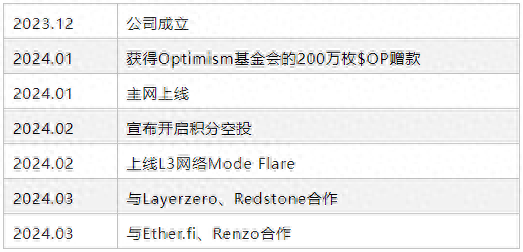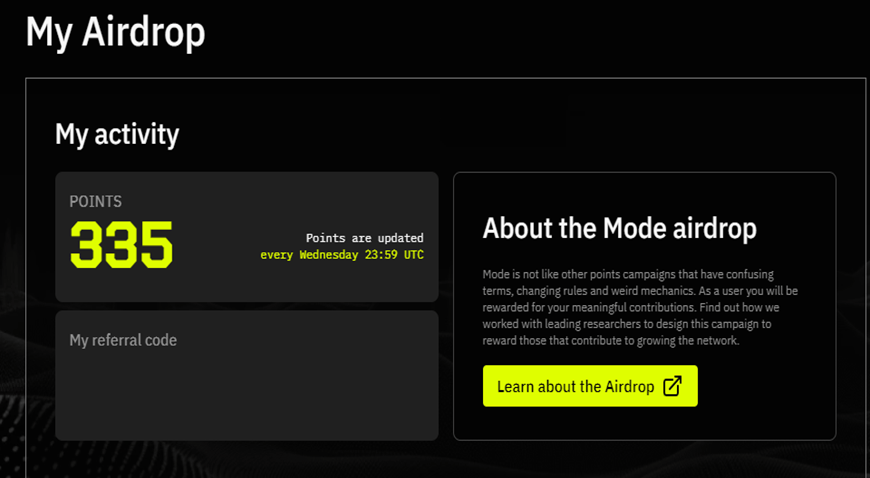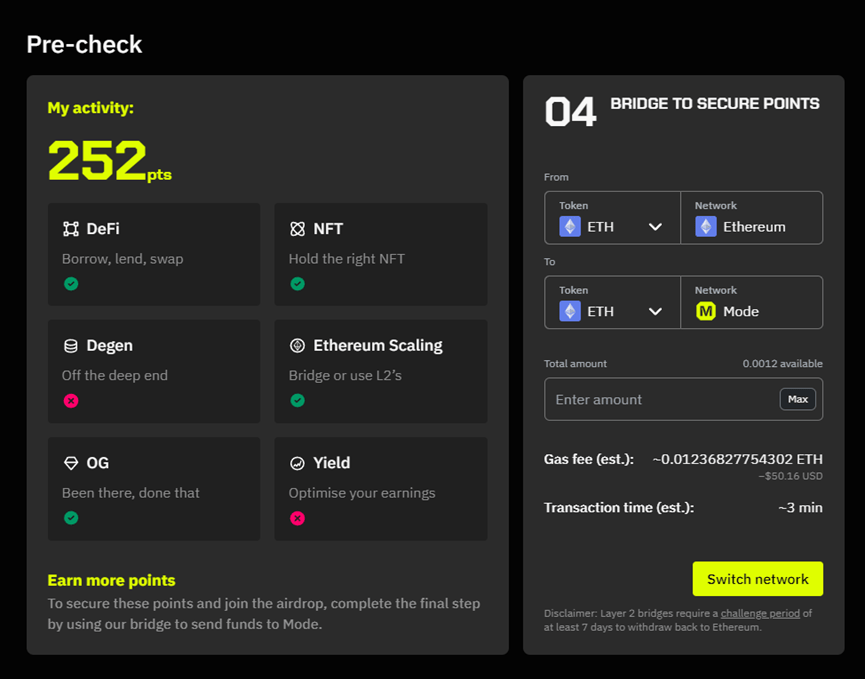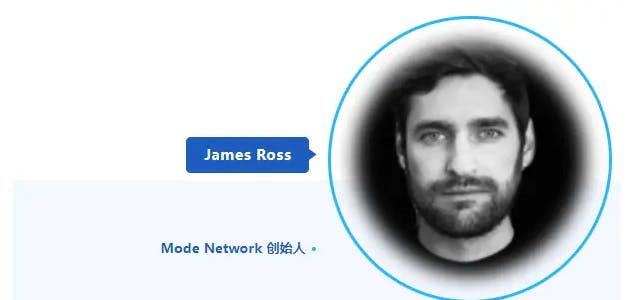One article provides a detailed explanation of the popular project Mode Network in the OP super chain
01 Introduction Mode Network is a modular Layer2 based on OP Stack that focuses on Defi tracks. It adopts Optimism's Bedlock upgrade, which can reduce costs by more than 95% compared to the Ethereum main network. The project received a $5.3 million donation from the Optimism Foundation in January 2024 (in the form of op tokens), and Mode will also donate some of the sorter revenue to the Optimism Collective. Mode maintains a good relationship with the Optimism Foundation, which is conducive to the development of the project.
02 Development Status Steady growth
TVL ranks among the top Mode was launched on the main network on January 31, 2024, and point airdrops began in February.

TVL has been steadily increasing since the independent online connection, ranking 13th among all Layer2 networks as of March 19, 2024, at $162 million, with a daily average TPS of 1.62 and a median GAS of 0.001 Gwei.

Converted to actual expenses of less than $0.01, there have been a total of 2.12 million transactions in the past thirty days. Interaction guide during airdrop The total number of Mode tokens is 10 billion, of which 5.5% are used for airdrops, and the specific token economics have not been released yet. Mode started airdropping points in February and is expected to issue coins in April. Users can earn airdropped tokens by accumulating points. Participate now and earn profits in less than a month. There are currently three ways to earn points: Old user rewards, Web3 old users will receive initial points based on their original blockchain interaction records when using wallet connections. These points can be activated through cross chain assets (with no requirement for amount); Recruiting rewards, users can obtain their own exclusive invitation code after activating points, and the inviter will receive a 16% point reward from the invitation code user; Ecological interaction rewards, interactive mode ecological applications can also earn points, and different types of projects will receive different point rewards. For developers, Mode implements: Sorter Revenue Rewards Developer airdrop rewards Optimism RPG Financing Rewards The developer's airdrop rewards amount to 500 million tokens, accounting for 5% of the total token count. The airdrop for developers is not related to the majority of users, so no detailed explanation will be provided. The specific interaction process for ordinary users is as follows:
- Check in Airdrop Activity Page( https://ref.mode.network )Check the initial points. If the points are not visible, it will display "INELIGIBLE TO CLAIM", indicating that the user is in a restricted IP and needs to be replaced.

- Bridging assets, users need to activate points from other network bridging assets, and ETH is required as a gas fee for airdrop activities. Bridging assets can be done using official bridges or third-party bridges. Using official bridges can only bridge assets from the main network, which incurs higher gas fees. Additionally, there is a seven day waiting period for the assets to be withdrawn, and MiniBridge can also be chosen( https://minibridge.chaineye.tools/ )By waiting for a third-party cross chain bridge, it is possible to bridge assets from other layers to Mode, resulting in relatively low bridging costs. The community administrator stated that the official bridge needs to be used at least once. Suggest using the official bridge first before using a third-party bridge.

- Interactive applications allow users to interact with applications on Mode to earn points. Different applications can earn different points. In addition, Mode has collaborated with lrt projects ether.fi and renzo, both of which have high TVL and sufficient funding, which is conducive to improving the TVL of Layer2. Sharing the "One Fish, Two Eats" strategy can bridge the weETH token and ezETH to Mode, which can simultaneously earn staking income, Eigenlayer points, lrt protocol points, and Mode points, which is beneficial for improving fund utilization. Analysis of various dimensions of project 03 Team background In terms of team, the Mode LinkedIn page has a total of 15 employees, but the number of its core employees is not large. From the perspective of their base areas, they may have adopted remote work methods. Founder James Ross is able to invest in eigenlayer and ethana, and his industry network should be good. Technical level Mode is a modular Layer2 network based on OP Stack. Currently, the Layer3 network Mode Flare, supported by Optimism and Celestia, has been launched, making it suitable for developing on chain games and trading platforms. In terms of technology, in addition to the concept of modularity, you also need to understand OP Stack and Mode Flare.

Modular blockchain Modular blockchain refers to a blockchain that focuses on handling a few tasks and outsources the rest to one or more independent layers. The purpose of modularity is to solve the impossible triangle of blockchain, namely security, decentralization, and scalability. This theory was proposed by Vitalik, the founder of Ethereum, and is considered one of the standards for testing public chain projects. We can see that the three most well-known projects on the public blockchain track, Bitcoin, Ethereum, and Solana, have different focuses in the impossible triangle of blockchain. Bitcoin has the strongest security and decentralization in the blockchain industry, but its scalability is almost zero. Solana is definitely the lowest in terms of security and decentralization, but it has the best scalability among these three. Modularization mainly involves dividing the consensus layer, execution layer, and data availability layer into different chains, such as settling on Ethereum, using Celestia for data availability, and then using SVM for execution in Solana. Through hierarchical decomposition, different requirements can be implemented on different blockchains to minimize the impact of "blockchain impossible triangle". Layer2 adopts modularity, including Mantle, Eclipse, Boba Network, etc. These projects actually have some gaps compared to the top projects of Layer2, but they have all won some new development opportunities through modularity. It can be said that modularity is one of the important narratives of this bull market.
Op Stacks The Stack service launched by Optimism, a leading project in Layer2, has been adopted by many well-known projects, such as Layer2 Base developed by Coinbase, Debank Chain developed by Debank, and Farcaster Stack developed by the social leader protocol Farcaster. Op Stack has been applied in multiple field projects, which is more in line with the Op Super Chain concept when Op Stack was first launched. The Op hyperchain refers to a network composed of dispersed Layer2, in which all Layer2 share security, communication layers, and open-source technology stacks, and these chains must comply with specific standards to enhance inter chain interoperability. Layer2 projects that use Op Stack services should typically be considered as members of the Op hyperlink. According to L2beat data, as of March 10, 2024, the top five projects in Layer2 TVL rankings are Arbitrum, OP Mainnet, Blast, Manta Pacific, and Starknet, respectively. Optimism ranks 29th in cryptocurrency market value, while Arbitrum ranks 47th. Its TVL ranking does not correspond to the token market value ranking. The key reason is that Optimism's Stack service is adopted by many project parties while Arbitrum does not, which is the narrative value brought by the Stack service. Therefore, joining the Op super chain should be beneficial for the development of the project at present.
Mode Flare The Layer3 network, supported by Optimism and Celestia, is designed for developers to deploy application chains. It features high throughput, fast deployment, EVM compatibility, flexible technology stack, and transaction costs below $0.005. Currently, three projects are preparing to launch Mode Flare, namely:
DEDPRZ, a cryptocurrency casino established using $USA tokens and DEDPRZ NFT
Liq Market, Decentralized Derivatives Exchange
Macaw, a predictive market for betting on political events or current news events Previously, some Layer2 projects have also launched Layer3 projects, such as Arbitrum's Xai. These Layer3 projects are mainly designed for cheaper gas fees and higher throughput, targeting game tracks with high interaction characteristics. Their application value is somewhat inferior to Layer2, but as a development direction, their upper limit is not low. Mode ecosystem Next, let's sort out some ecological projects that have already been launched in Mode. Ether.fi is a liquidity re pledge agreement based on the Ethereum main network in the Eigenlayer ecosystem, allowing users to re pledge ETH or other liquidity re pledge tokens to generate lrt tokens and obtain eETH in a 1:1 ratio. Ether. fi is a leading agreement in the liquidity re pledge track, with a TVL of $2.67 billion and a two round financing limit of $32.3 million. Investors include CoinFund, North Island Ventures, OKX Ventures, and others. Renzo is a liquidity re pledge agreement based on the Ethereum main network in the Eigenlayer ecosystem. Users can re pledge ETH or other liquidity re pledge tokens to generate lrt tokens and obtain ezETH in a 1:1 ratio. Renzo ranks third in the liquidity re pledge track, with Ether.fi and Puffer Finance, with a TVL of $990 million. Seed round financing of 3.2 million US dollars, with investors including renowned institutions such as Binance Labs, OKX Ventures, IOSG Ventures, and Robot Ventures. Kim Exchange is a decentralized exchange native to Mode, driven by the community and providing customizable protocols. It provides users with greater incentives through Mode's sorting and fee sharing mechanism, with a TVL of $6.45 million. IONIC is a lending agreement on Mode, supported by MetaCartel Ventures, Ohm, and Mode. Ionic aims to provide the best interest rate on Mode and has designed a targeted economic model that helps balance the interests of both borrowers and lenders, with a TVL of $61 million. The founder is Henri Mahal and the investor is MetaCartel Ventures. Mode Name Service is a domain name service provided by Space ID, with a domain name format of As of March 10, 2024, a total of 75.7k domain names have been registered, with a total of 70.3k holders. LogX is a perpetual contract exchange that uses Bitcoin and Ethereum for trading, designed as a large aggregator that brings together liquidity from different chains. Users do not need to manage Gas tokens or execute multiple transactions for each operation, with a TVL of $11.21 million. Poolshark is a decentralized protocol for directed liquidity, which has been launched in Layer 2 of Mode, Arbitrum, and Scroll. Through directed liquidity, fund pool depositors can create sell only liquidity positions. Poolshark can provide limit order trading for professional traders on dex, with a TVL of $595000. Layerbank is a full chain lending agreement that involves multiple fields such as LSD, RWA, LRT, etc. It has been launched on multiple Layer2 platforms such as Manta, Bsquared, Mode, Linea, and Scroll, with a total of $414 million, of which the TVL on Mode is $10.11 million. Overall, the ecosystem of Mode is mainly focused on Defi projects, which have relatively interactive value. Mode is currently committed to collaborating with liquidity re pledge projects, which is beneficial for both parties - Mode can acquire more users and funds, and the tokens for liquidity re pledge projects have more usage scenarios. 04 Modular Layer2 Competitive Landscape Mode is a modular Layer2 that uses Op Stack services, so we choose other Layer2 that use Stack services or modular Layer2 as comparison objects. 05 Summary Mode is a modular Layer2 project that uses Op Stack and focuses on the Defi track. The Op Super Chain created by Op Stack has attracted many well-known projects, which is conducive to attracting users and expanding the ecosystem. Meanwhile, modularity is one of the key narratives of this bull market. The improvement of public chain performance cannot solely rely on the same public chain, and modularization is conducive to leveraging the advantages of each public chain. Therefore, modular leading projects have shown good performance. Overall, Mode is in line with the current development path of Layer2, and its project results are worth looking forward to. From the perspective of competitive landscape, Mode has also performed well in similar projects and is committed to becoming a DeFi Hub in the op super chain. Its future development is worth paying attention to
